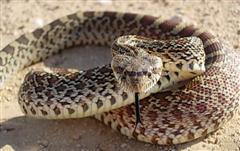Bull Snake
Bullsnake, Gopher Snake, Pine Snake Scientific Name: Pituophis sp.
Sat, 12th July, 2025 - 3:53 am GMT
Sponsor Ads:

Alternative Name
Bullsnake, Gopher Snake, Pine Snake Scientific Name: Pituophis sp.Basic Info
Bull Snakes are quite large, some have been reported as reaching as much as nine feet in length. Most Bull Snakes average around five feet. Common colors for the Bull Snake include yellowish-brown, cream and brown. They usually have black and/or brown markings and a light brown belly. There is also an alibino variety which is yellow and red. The albindo will always have red eyes. A large nose shield characterizes the snake's smallish head, which is useful in burrowing. While not venomous, the Bull Snake does have teeth and will bite if provoked. Each snake will have a unique pattern on their heads, making it easy to distinguish one snake from another. The Bull Snake is preyed upon by birds of prey such as hawks and eagles. They use defense mechanisms, such as rattling their tail in dry leaves and hissing, to mimic a rattlesnake and ward off predators.
Health
The Bull Snake requires a large enclosure of at least 4' x 2' x 2'. Wild-caught juveniles will likely become more docile after frequent handling, although wild-caught adults will likely remain aggressive. Bull Snakes should be given a basking area with slightly higher temperatures than the ambient 78 to 85 degrees Fahrenheit. At night, the temperature should be between 70 and 75 degrees Fahrenheit. They also should be provided with hiding areas that can be formed with rocks or bricks. High humidity is not necessary and the Bull Snake only needs a small water dish for drinking. Captive Bull Snakes can be fed mice, rats and sometimes small rabbits. Breeding The Bull Snake's mating season is in the spring. The females lay a clutch of between three and twenty eggs in a shallow hole, which they dig themselves. The off-white colored eggs will hatch after between 64 and 80 days of incubation. The hatchlings, which are on their own as soon as they're born, average between one and one and a half feet in length.Habitat
Native to the Mid-Western United States, the Bull Snake inhabits fields, brush, open forests and prairies.Behavior
The Bull Snake, also known as the Gopher Snake or the Pine Snake, is one of the largest snakes native to North America, and has only a few natural predators. Like all snakes, Bull Snakes can be aggressive if they are not handled often. If they are handled from the time they are hatchlings they can be quite docile. The basic rule of thumb is - the more you handle your snake the easier it will be to handle it. This is not always true but it is often the case. Like many snakes, wild caught adult individuals are less likely to become more docile, even with handling. A Bull Snake, after a large meal, needs no food for quite awhile and may rest for several weeks. Bull Snakes are known for the ability to make loud hissing noises. They are also known to vibrate their tail and when this is done in dry leaves it produces a sound that mimics rattlesnakes. Bull Snakes mate in the spring.Origin
North AmericaHistory
N/ACommon Foods
Bull Snakes generally feed on small animals including mice, rabbits, ground squirrels and gophers. They are also known to feed on bird eggs and ground nesting birdsSponsor Ads:
Computers are useless. They can only give you answers. -- Pablo Picasso (1881-1973)
Bull Snake
Coded by: BGID® | ALL RIGHTS RESERVED Copyright © 2000-2025
Disclaimer | Privacy | Report Errors / Contact | Credits








 President of the United States of America - Real Estate mogul, Pageant owner and now one of the most controversial men in political history.
President of the United States of America - Real Estate mogul, Pageant owner and now one of the most controversial men in political history.  Global warming has been in and out as the "latest" hot topic for many years. It is, according to modern scientists, the result of man-made industrial pollutants, clearing forested areas, agriculture, etc. But now they are thinking it started way before the Industrial Revolution...
Global warming has been in and out as the "latest" hot topic for many years. It is, according to modern scientists, the result of man-made industrial pollutants, clearing forested areas, agriculture, etc. But now they are thinking it started way before the Industrial Revolution...  Politician, US Vice President and President of the USA - Joseph Robinette Biden Jr.
Politician, US Vice President and President of the USA - Joseph Robinette Biden Jr.  versus
versus  Russia: 'The Evil Empire'? Are they all that bad or is it just the USA trying to portray Russia as bad because they are a world power with land bigger and a society very different from the USA ideal?
Russia: 'The Evil Empire'? Are they all that bad or is it just the USA trying to portray Russia as bad because they are a world power with land bigger and a society very different from the USA ideal? 
 Corona virus
Corona virus 
 Users with wide screen monitors can benefit from more content on every page.
Users with wide screen monitors can benefit from more content on every page.